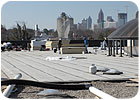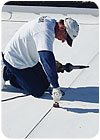Technical Details: Essential Elements For Successful Roof Applications
What is the best roof system? This question is posed to members of our industry on a daily basis. Although there are strong opinions from all sectors of the industry on the answer to this question, the answer actually depends on several factors.

What is the best roof system? This question is posed to members of our industry on a daily basis. Although there are strong opinions from all sectors of the industry on the answer to this question, the answer actually depends on several factors. Each building is different, and the circumstances surrounding each project could alter the roof system choice. The successful performance of a roof system requires the following criteria: proper design, quality materials, quality workmanship, weather considerations and timely maintenance.

In the past decade, building owners have become more active in specifying the types of application methods that they require at their facilities. This has often forced designers and contractors to apply systems that comply with the owner's constraints. Oftentimes owners are concerned with noise, smoke and access to interior work areas during construction. Providing systems that meet the owner's constraints and still provide waterproofing protection to the facility can be challenging, and these details must be thoroughly considered during the design phase.
Proper design also includes selecting materials and systems that are compatible with existing building conditions. For instance, the type of deck and slope of the deck will influence the types of materials that are applied. The geographic and environmental conditions of the building's location should also play a role in system selection. Buildings located in high-velocity wind zones and areas prone to frequent hailstorms require special design considerations.
Proper design should always be completed with the intent of providing a long-term roofing system on the facility. Designing systems to meet the owner's limited economic constraints should be designated as a short-term repair and should be fully documented as such.


Roofs are exposed to the elements 24 hours a day, every day of the year. In the summer the roof surface temperature can exceed 200°F. In the winter, the roof surface can be exposed to continual snow and ice for weeks at a time. In addition, the spring and fall winds exert more force at the roof level than at any other exterior building component.
The most important reason to implement an annual roof maintenance program is to extend the service life of the existing roof system. Comprehensive repairs extend the service life of the roof system and provide cost savings to the owner. A roof maintenance program establishes of a proactive posture in the detection and avoidance of leaks and other roofing problems. Problems are addressed at their initial stage, minimizing and eliminating damage to interior furnishings, equipment, building materials and finishes in the event of a leak. In this way, the owner avoids expenditures for such items as deck damage repair and associated costs resulting from reactive maintenance. Development of maintenance guidelines is based on the profile of the roof systems in place.
Minor problems can be detected at their initial stages and corrected before they become severe, extensive problems. Building owners should view roof maintenance operations similar to the way they view mortgage insurance. A manageable yearly expense could provide the dividends of a roof system that meets or exceeds its anticipated service life. For instance, a 20-year roof system that protects the building beyond 20 years could be considered free money to the owner.
Similar to preventive maintenance on manufacturing equipment, once the roof system has extended its depreciated service life, the owner receives a return on expenditures. Every year that the roof system is extended is an additional year that the owner does not have to incur a substantial expense for remedial roof construction.

What is the best roof system? This question is posed to members of our industry on a daily basis. Although there are strong opinions from all sectors of the industry on the answer to this question, the answer actually depends on several factors. Each building is different, and the circumstances surrounding each project could alter the roof system choice. The successful performance of a roof system requires the following criteria: proper design, quality materials, quality workmanship, weather considerations and timely maintenance.

Concern about noise, smoke and access to interior work areas during construction can affect the loading and application of roofing materials. Providing systems that meet the owner's constraints and still provide waterproofing protection to the facility can be challenging.
Proper Design
Proper design is an important element of a successful roof application. Key components to proper design include wind uplift calculations, drainage design, thermal factors, perimeter edge design and existing building conditions. All of the aforementioned calculations and considerations should be conducted on all roof projects.In the past decade, building owners have become more active in specifying the types of application methods that they require at their facilities. This has often forced designers and contractors to apply systems that comply with the owner's constraints. Oftentimes owners are concerned with noise, smoke and access to interior work areas during construction. Providing systems that meet the owner's constraints and still provide waterproofing protection to the facility can be challenging, and these details must be thoroughly considered during the design phase.
Proper design also includes selecting materials and systems that are compatible with existing building conditions. For instance, the type of deck and slope of the deck will influence the types of materials that are applied. The geographic and environmental conditions of the building's location should also play a role in system selection. Buildings located in high-velocity wind zones and areas prone to frequent hailstorms require special design considerations.
Proper design should always be completed with the intent of providing a long-term roofing system on the facility. Designing systems to meet the owner's limited economic constraints should be designated as a short-term repair and should be fully documented as such.

Quality installations require skilled applicators that are familiar with the materials that are being installed. (Photo courtesy of Performance Roof Systems.)
Quality Materials
Not all roof materials are the same, and not all materials are suitable for all buildings. The short-term and log-term costs of materials and their performance must be subjected to comparison. Long-term roof performance requires quality materials. Minor economic savings in material costs could result in shortened service life. The types of materials applied should be compatible with the building conditions and applied in accordance with the manufacturers' latest printed requirements. The applied materials must be new, free of all moisture and manufactured in compliance with ASTM standards. Proper material storage at the project site is also essential.Quality Workmanship
The roof is one of a few major building components that is fully constructed on the site. It is a system of multiple components and diverse materials. Although there is some repetition in component applications for typical work crews, detail work can vary from day to day. Specialty crews that apply the same types of systems on every project are becoming increasingly rare. Current roof mechanics are being asked to apply all types of systems and may not complete the same system on two consecutive projects for months. This diverse workload demands applicators with greater versatility. Quality installations require skilled applicators that are familiar with the materials that are being installed. The fact is that a large percentage of premature roof failures can be attributed to improper workmanship, so it is a given that system applicators should be properly trained to apply the materials in compliance with the manufacturers' requirements.Weather Considerations
All of the current roof materials and systems have ambient temperature constraints. Application of these materials in wet weather conditions or in temperatures that are outside the material's constraints (too hot or too cold) will contribute to premature failure. The recent surge in the use of cold adhesive materials in the industry has underscored the need to provide material application in the proper temperature range.
It is essential that work crews are properly trained to apply the materials in compliance with the manufacturers' requirements, including any weather-related restrictions. (Photos courtesy of Performance Roof Systems.)
Timely Maintenance
There is no such thing as a maintenance-free roof system. All types of roofs require a certain level of attention. In fact, from the moment of installation, the roofing system undergoes continuous deterioration. Extreme temperature fluctuations as well as snow, ice, hail and wind prevail upon the roofing surface. In short, the elements are the biggest deterrents to the roof system over its service life. Traffic on the roof and the installation of mechanical and other equipment can also cause physical damage that contributes significantly to roofing failures.Roofs are exposed to the elements 24 hours a day, every day of the year. In the summer the roof surface temperature can exceed 200°F. In the winter, the roof surface can be exposed to continual snow and ice for weeks at a time. In addition, the spring and fall winds exert more force at the roof level than at any other exterior building component.
The most important reason to implement an annual roof maintenance program is to extend the service life of the existing roof system. Comprehensive repairs extend the service life of the roof system and provide cost savings to the owner. A roof maintenance program establishes of a proactive posture in the detection and avoidance of leaks and other roofing problems. Problems are addressed at their initial stage, minimizing and eliminating damage to interior furnishings, equipment, building materials and finishes in the event of a leak. In this way, the owner avoids expenditures for such items as deck damage repair and associated costs resulting from reactive maintenance. Development of maintenance guidelines is based on the profile of the roof systems in place.
Minor problems can be detected at their initial stages and corrected before they become severe, extensive problems. Building owners should view roof maintenance operations similar to the way they view mortgage insurance. A manageable yearly expense could provide the dividends of a roof system that meets or exceeds its anticipated service life. For instance, a 20-year roof system that protects the building beyond 20 years could be considered free money to the owner.
Similar to preventive maintenance on manufacturing equipment, once the roof system has extended its depreciated service life, the owner receives a return on expenditures. Every year that the roof system is extended is an additional year that the owner does not have to incur a substantial expense for remedial roof construction.
Links
Looking for a reprint of this article?
From high-res PDFs to custom plaques, order your copy today!


